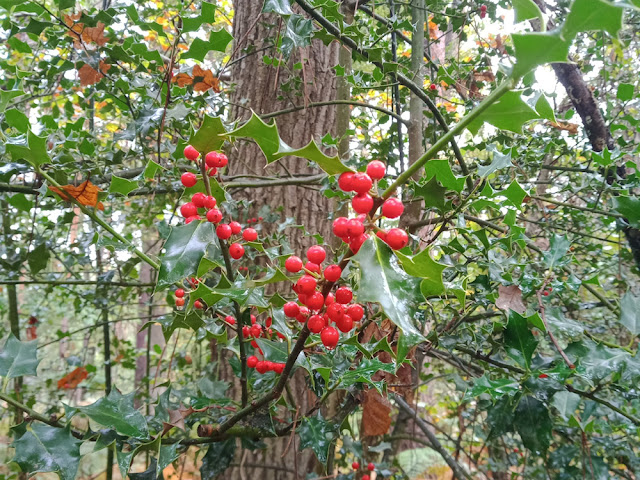Holly Ilex aquifolium (Fr. Houx).
Holly is a small evergreen tree. There are lots of species of Ilex, but I. aquifolium is the only one native to Europe. It is in fact native to all of the temperate Old World.
It is abundant, and grows up to 1500 metres above sea level. Because of its persistent glossy green leaves and red berries it is much sought after in France as a Christmas decoration. Like box, laurel, yew, ivy, broom, gorse and mistletoe it has been associated with the winter solstice since ancient times and now New Year too, as a symbol of the persistence of life even in the depths of winter. Its association with Christmas is an adoption of an existing pagan mid-winter practice. Conveniently the spines and berries adapt well to an association with the crown of thorns and Christ's blood in addition.
The English 'holly' and the French 'houx' come from the same old German root word 'hulis', meaning 'spiny plant'. The specific name 'aquifolium' means 'spiny leaved', and the genus name 'ilex' means 'evergreen oak'.
There are many place names in France that reference holly eg la Houssaye ('the holly wood') or Arpheuilles ('sharp leaves').
Holly is slow growing, with dense wood. A mature holly is generally about 5 metres tall, and can live for several hundred years.
The leaves are tough, and variable in their number of spines. Leaves last about 3 years and the ones which grow in winter tend to be spinier. The spines are to protect the tree from browsers such as deer.
Holly trees are generally either male or female, with only the females producing berries. Pollinisation is by insects, and seeds distributed by birds, usually thrushes (including blackbirds) and wood pigeons as they eat the berries. For these species it is a very important winter food. Likewise the tree provides important cover for deer and wild boar (and in Christian legend, for the Holy Family fleeing Herod).
Holly is a plant of the forest understorey, and thrives in damp shaded rich slightly acid soils. It will also adapt well to calcareous soil, so long as the humidity is high enough. It survives because of an enhanced ability to photosynthesise in the shade and in the winter, but it can't take too much cold.
Holly is present throughout France, and there are several significant holly forests in the south of the country.
The berries and leaves contain various toxins, but you would have to consume a lot to be poisoned, and the berries are bitter, so not very enticing after the first taste. Most likely you would vomit it up before it killed you, and cases of poisoning are very rare.
In Alsace and the Black Forest there are traditional drinks made from holly, such as an eau de vie from the berries and a tea from the leaves (like the South American maté, which is also made from a species of holly).
Not much attacks holly, but it does have its own leaf mining fly larvae, and its own aphid, both specific to holly.
Notoriously, holly bark is the source of glu, a viscous substance used to trap birds. The bark is left to ferment in spring water and after some manipulation a greenish water resistant paste is produced. This is mixed with poultry fat, vinegar, oil, and turpentine, boiled whilst stirring and when ready spread on vines and fruit trees to protect against insects and birds.
Holly wood is very pale, dense and evenly grained, so it is prized by marquetry workers. It is traditionally used to make the white pieces for a chess set, and in various musical instruments.
It has been used in hedges to enclose stock.








No comments:
Post a Comment